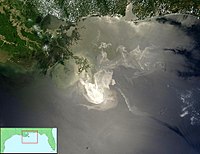
Photo from wikipedia
The Deepwater Horizon oil rig accident, in 2010, is considered the biggest disaster of the 21st century in the oil and gas industry. A total of 11 workers died, 17… Click to show full abstract
The Deepwater Horizon oil rig accident, in 2010, is considered the biggest disaster of the 21st century in the oil and gas industry. A total of 11 workers died, 17 were injured, total loss of the unit, and the largest environmental disaster in the Gulf of Mexico (United States). The existing literature encompasses its environmental, chemical, biological, and economic effects, focusing on immediate causes, that is, situations close to the event in time and space, especially human errors and technical failures. This approach is taken at the expense of identifying possible underlying causes, which refer to managerial and organizational factors. This essay aims to answer the question: wich factors may have contributed to the disaster that affected the platform, considering the relevance of the collective dimension of work? Our theoretical-methodological contribution is based on the activity ergonomics and the work psychodynamics, also valuing the synergistic conduction of the relationship between the knowledge of the sciences and the experience of the workers, as proposed by the ergological perspective. We identified decision failures from those who are at the tip of the process, operating systems of high complexity, that should not be interpreted as an endpoint, but as a starting point in the analysis of major accidents. Understanding such decisions demands the comprehension of the representations constructed by the workers, including in their collective and shared dimension. The communication (or communication gaps) between workers and organizational factors in the context of the accident are essential aspects to be considered in the analysis of events involving complex systems.
Journal Title: Cadernos de saude publica
Year Published: 2022
Link to full text (if available)
Share on Social Media: Sign Up to like & get
recommendations!